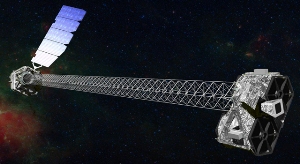Aug 4 2014
NASA's Nuclear Spectroscopic Telescope Array, or NuSTAR, a premier black-hole hunter among other talents, has finished up its two-year prime mission, and will be moving onto its next phase, a two-year extension.
 Artist's concept of NuSTAR on orbit. NuSTAR has a 10-m (30') mast that deploys after launch to separate the optics modules (right) from the detectors in the focal plane (left). Image credit: NASA/JPL-Caltech
Artist's concept of NuSTAR on orbit. NuSTAR has a 10-m (30') mast that deploys after launch to separate the optics modules (right) from the detectors in the focal plane (left). Image credit: NASA/JPL-Caltech
"It's hard to believe it's been two years since NuSTAR launched," said Fiona Harrison, the mission's principal investigator at the California Institute of Technology in Pasadena. "We achieved all the mission science objectives and made some amazing discoveries I never would have predicted two years ago."
In this new chapter of NuSTAR's life, it will continue to examine the most energetic objects in space, such as black holes and the pulsating remains of dead stars. In addition, outside observers -- astronomers not on the NuSTAR team -- will be invited to compete for time on the telescope.
"NuSTAR will initiate a general observer program, which will start execution next spring and will take 50 percent of the observatory time," said Suzanne Dodd, the NuSTAR project manager at NASA's Jet Propulsion Laboratory in Pasadena, California. "We are very excited to see what new science the community will propose to execute with NuSTAR."
NuSTAR blasted into space above the Pacific Ocean on June 13, 2012, with the help of a plane that boosted the observatory and its rocket to high altitudes. After a 48-day checkout period, the telescope began collecting X-rays from black holes, supernova remnants, galaxy clusters and other exotic objects. With its long mast - the length of a school bus -- NuSTAR has a unique design that allows it to capture detailed data in the highest-energy range of X-rays, the same type used by dentists. It is the most sensitive high-energy X-ray mission every flown.
In its prime mission, NuSTAR made the most robust measurements yet of the mind-bending spin rate of black holes and provided new insight into how massive stars slosh around before exploding. Other observations include: the discovery of a highly magnetized neutron star near the center of our Milky Way galaxy, measurements of luminous active black holes enshrouded in dust, and serendipitous discoveries of supermassive black holes.
NuSTAR is now funded through fiscal year 2016 in its current extended phase.
It is a Small Explorer mission led by Caltech and managed by JPL for NASA's Science Mission Directorate in Washington. The spacecraft was built by Orbital Sciences Corporation, Dulles, Virginia. Its instrument was built by a consortium including Caltech; JPL; the University of California, Berkeley; Columbia University, New York; NASA's Goddard Space Flight Center, Greenbelt, Maryland; the Danish Technical University in Denmark; Lawrence Livermore National Laboratory, Livermore, California; ATK Aerospace Systems, Goleta, California, and with support from the Italian Space Agency (ASI) Science Data Center.
NuSTAR's mission operations center is at UC Berkeley, with the ASI providing its equatorial ground station located at Malindi, Kenya. The mission's outreach program is based at Sonoma State University, Rohnert Park, California. NASA's Explorer Program is managed by Goddard. JPL is managed by Caltech for NASA.